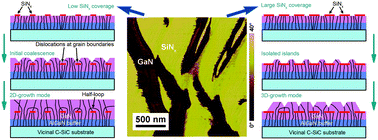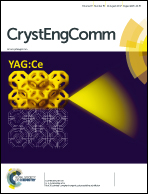The growth optimization and mechanism of N-polar GaN films with an in situ porous SiNx interlayer
Abstract
In this paper, N-polar GaN films were grown on vicinal C-face SiC substrates by metal–organic chemical vapor deposition. In situ porous SiNx interlayers with different deposition times of 0 s to 120 s were adopted in the growth processes of N-polar GaN films. We find that the crystalline quality, such as surface morphology and structural characteristics, of N-polar GaN films can be controlled by changing the deposition time of the SiNx interlayers. The N-polar GaN film with a SiNx deposition time of 60 s exhibits the best crystallinity. Based on the observed porous feature of the SiNx interlayer from the phase image obtained using an atomic force microscope, we propose a model to illustrate the epitaxial growth mechanism of N-polar GaN films grown on the top of the porous SiNx interlayer. In this model, we reveal that the SiNx deposition time determines the SiNx coverage and the nucleated island density of overgrown GaN, which markedly affects the structural characteristics of the N-polar GaN films. This model can also be used to analyze the influence of SiNx deposition times on the stress states in N-polar GaN films. Additionally, the threading dislocation propagation behaviors were observed experimentally from the cross-sectional transmission electron microscopy image of N-polar GaN with a SiNx interlayer, which demonstrates the reasonability of this model. It is reasonably believed that this work provide a valuable information to obtain high-quality GaN films that can be used to the fabrication of N-polar GaN-based optoelectronic devices.



 Please wait while we load your content...
Please wait while we load your content...